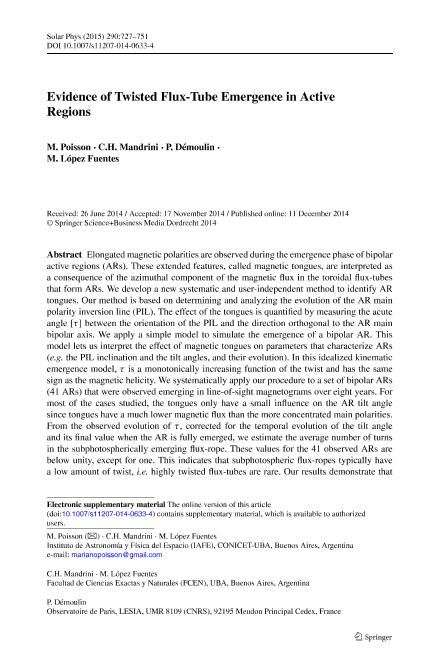Mostrar el registro sencillo del ítem
dc.contributor.author
Poisson, Mariano

dc.contributor.author
Mandrini, Cristina Hemilse

dc.contributor.author
Démoulin, Pascal

dc.contributor.author
Lopez Fuentes, Marcelo Claudio

dc.date.available
2017-06-02T20:11:39Z
dc.date.issued
2015-03
dc.identifier.citation
Poisson, Mariano; Mandrini, Cristina Hemilse; Démoulin, Pascal; Lopez Fuentes, Marcelo Claudio; Evidence of twisted flux tube emergence in active regions; Springer; Solar Physics; 290; 3; 3-2015; 727-751
dc.identifier.issn
0038-0938
dc.identifier.uri
http://hdl.handle.net/11336/17414
dc.description.abstract
Elongated magnetic polarities are observed during the emergence phase of bipolar active regions (ARs). These extended features, called magnetic tongues, are interpreted as a consequence of the azimuthal component of the magnetic flux in the toroidal flux-tubes that form ARs. We develop a new systematic and user-independent method to identify AR tongues. Our method is based on determining and analyzing the evolution of the AR main polarity inversion line (PIL). The effect of the tongues is quantified by measuring the acute angle [τ] between the orientation of the PIL and the direction orthogonal to the AR main bipolar axis. We apply a simple model to simulate the emergence of a bipolar AR. This model lets us interpret the effect of magnetic tongues on parameters that characterize ARs (e.g. the PIL inclination and the tilt angles, and their evolution). In this idealized kinematic emergence model, τ is a monotonically increasing function of the twist and has the same sign as the magnetic helicity. We systematically apply our procedure to a set of bipolar ARs (41 ARs) that were observed emerging in line-of-sight magnetograms over eight years. For most of the cases studied, the tongues only have a small influence on the AR tilt angle since tongues have a much lower magnetic flux than the more concentrated main polarities. From the observed evolution of τ, corrected for the temporal evolution of the tilt angle and its final value when the AR is fully emerged, we estimate the average number of turns in the subphotospherically emerging flux-rope. These values for the 41 observed ARs are below unity, except for one. This indicates that subphotospheric flux-ropes typically have a low amount of twist, i.e. highly twisted flux-tubes are rare. Our results demonstrate that the evolution of the PIL is a robust indicator of the presence of tongues and constrains the amount of twist in emerging flux-tubes.
dc.format
application/pdf
dc.language.iso
eng
dc.publisher
Springer

dc.rights
info:eu-repo/semantics/openAccess
dc.rights.uri
https://creativecommons.org/licenses/by-nc-sa/2.5/ar/
dc.subject
Active Regions
dc.subject
Magnetic Fields
dc.subject
Coronal Structures
dc.subject
Magnetic Helicity
dc.subject.classification
Astronomía

dc.subject.classification
Ciencias Físicas

dc.subject.classification
CIENCIAS NATURALES Y EXACTAS

dc.title
Evidence of twisted flux tube emergence in active regions
dc.type
info:eu-repo/semantics/article
dc.type
info:ar-repo/semantics/artículo
dc.type
info:eu-repo/semantics/publishedVersion
dc.date.updated
2017-06-01T16:46:55Z
dc.journal.volume
290
dc.journal.number
3
dc.journal.pagination
727-751
dc.journal.pais
Alemania

dc.journal.ciudad
Berlin
dc.description.fil
Fil: Poisson, Mariano. Consejo Nacional de Investigaciónes Científicas y Técnicas. Oficina de Coordinación Administrativa Ciudad Universitaria. Instituto de Astronomía y Física del Espacio. - Universidad de Buenos Aires. Facultad de Ciencias Exactas y Naturales. Instituto de Astronomía y Física del Espacio; Argentina
dc.description.fil
Fil: Mandrini, Cristina Hemilse. Consejo Nacional de Investigaciónes Científicas y Técnicas. Oficina de Coordinación Administrativa Ciudad Universitaria. Instituto de Astronomía y Física del Espacio. - Universidad de Buenos Aires. Facultad de Ciencias Exactas y Naturales. Instituto de Astronomía y Física del Espacio; Argentina
dc.description.fil
Fil: Démoulin, Pascal. Centre National de la Recherche Scientifique. Observatoire de Paris; Francia
dc.description.fil
Fil: Lopez Fuentes, Marcelo Claudio. Consejo Nacional de Investigaciónes Científicas y Técnicas. Oficina de Coordinación Administrativa Ciudad Universitaria. Instituto de Astronomía y Física del Espacio. - Universidad de Buenos Aires. Facultad de Ciencias Exactas y Naturales. Instituto de Astronomía y Física del Espacio; Argentina
dc.journal.title
Solar Physics

dc.relation.alternativeid
info:eu-repo/semantics/altIdentifier/url/http://link.springer.com/article/10.1007%2Fs11207-014-0633-4
dc.relation.alternativeid
info:eu-repo/semantics/altIdentifier/doi/http://dx.doi.org/10.1007/s11207-014-0633-4
dc.relation.alternativeid
info:eu-repo/semantics/altIdentifier/arxiv/https://arxiv.org/abs/1505.01805
Archivos asociados
